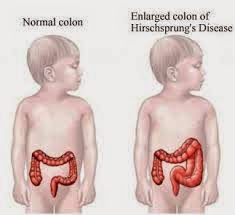Hirschsprung's disease is a disorder of the abdomen that occurs when part or all of the large intestine or antecedent parts of the gastrointestinal tract have no ganglion cells and therefore cannot function. During normal fetal development, cells from the neural crest migrate into the large intestine (colon) to form the networks of nerves called Auerbach's plexus and Meissner's plexus. In Hirschsprung's disease, the migration is not complete and part of the colon lacks these nerve bodies that regulate the activity of the colon. The affected segment of the colon cannot relax and pass stool through the colon, creating an obstruction. In most affected people, the disorder affects the part of the colon that is nearest the anus. In rare cases, the lack of nerve bodies involves more of the colon. In five percent of cases, the entire colon is affected. Stomach and esophagus may be affected too. Hirschsprung's disease is also often called congenital aganglionic megacolon.
Symptoms that may be present in newborns and infants include:
- Difficulty with bowel movements
- Failure to pass meconium shortly after birth
- Failure to pass a first stool within 24 - 48 hours after birth
- Infrequent but explosive stools
- Jaundice
- Poor feeding
- Poor weight gain
- Vomiting
- Watery diarrhea (in the newborn)
Symptoms in older children:
- Constipation that gradually gets worse
- Fecal impaction
- Malnutrition
- Slow growth
- Swollen belly
10 Nursing Diagnosis for Hirschsprung's Disease
- Risk for constipation
- Risk for fluid / electrolyte volume imbalance
- Risk for injury
- Acute pain
- Risk for Shock (hypovolemic)
- Risk for Imbalanced Nutrition, Less Than Body Requirements
- Risk for infection
- Knowledge Deficit
- Risks for Growth and Development
- Anxiety
Reference :
http://en.wikipedia.org/wiki/Hirschsprung%27s_disease
http://www.nlm.nih.gov/medlineplus/ency/article/001140.htm
